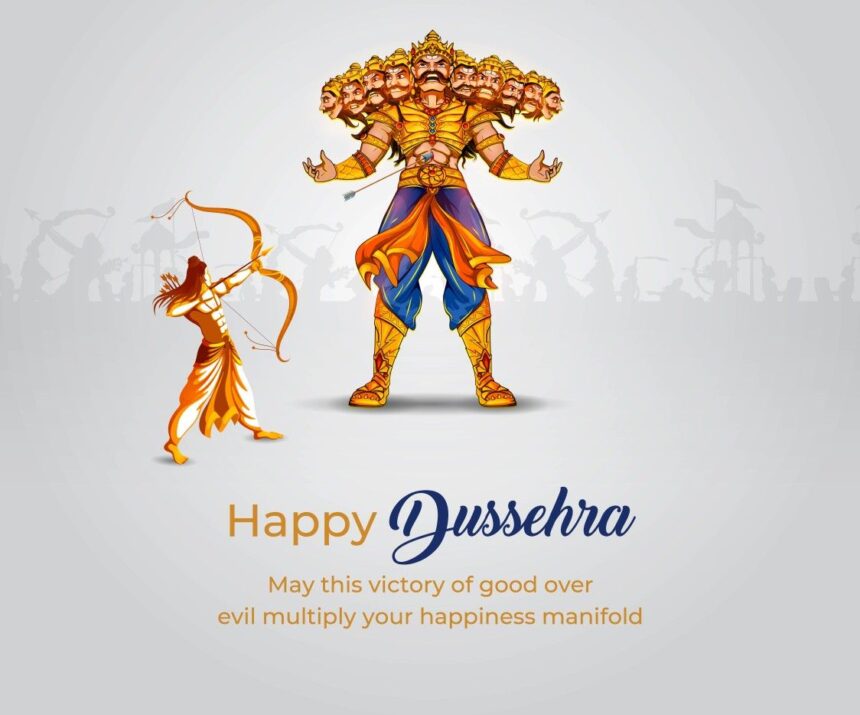Dussehra: Overview
Dussehra, also known as Vijayadashami, is a major Hindu festival celebrated across India. It symbolizes the victory of good over evil and marks the triumph of Lord Rama over the demon king Ravana. The festival is observed on the tenth day of the Hindu month of Ashwin, usually in September or October, following Navratri.
Dussehra is not only a religious celebration but also a cultural and social festival, highlighting moral values, courage, and righteousness.
History of Dussehra
Dussehra has its roots in Hindu mythology and epics:
Lord Rama and Ravana:
According to the Ramayana, Dussehra marks the day Lord Rama defeated Ravana in Lanka to rescue his wife, Sita.
The festival symbolizes the triumph of virtue and righteousness over evil.
Goddess Durga and Mahishasura:
In some regions, Dussehra celebrates the victory of Goddess Durga over the buffalo demon Mahishasura, representing the victory of good over evil forces.
Cultural Significance:
Dussehra has historically been associated with royal ceremonies and moral teachings, emphasizing dharma (righteousness) and social harmony.
Significance of Dussehra
Spiritual Significance:
Symbolizes the victory of good over evil.
Encourages moral living, courage, and devotion.
Cultural Significance:
Promotes traditional art forms, folk theatre, and community gatherings.
Reinforces lessons from epics and legends.
Social Significance:
Strengthens family and community bonds through collective celebration.
Inspires acts of goodwill, charity, and social unity.
Rituals and Celebrations
Dussehra is celebrated with varied customs across India, blending religious, cultural, and social traditions:
1. Ram Lila Performances
Many regions stage Ram Lila, a dramatic enactment of the Ramayana, showing Rama’s journey and battle with Ravana.
These performances culminate on Dussehra day, creating a sense of devotion and moral reflection.
2. Effigy Burning
The highlight of Dussehra is the burning of Ravana, Kumbhkaran, and Meghnath effigies.
Fireworks accompany the ritual, symbolizing the destruction of evil and triumph of righteousness.
3. Worship of Goddess Durga
In eastern India, particularly in West Bengal, Dussehra coincides with Vijaya Dashami, marking the end of Durga Puja.
Devotees immerse Durga idols in water, signifying her return to Mount Kailash and the victory over Mahishasura.
4. Fasting and Prayers
Many people observe fasts, perform pujas, and chant mantras for prosperity, protection, and spiritual growth.
5. Community Feasts and Cultural Programs
People organize community gatherings, fairs, and cultural programs, celebrating with food, music, and dance.
Dussehra Across India
North India: Emphasizes Ram Lila and effigy burning, especially in cities like Delhi, Varanasi, and Jaipur.
West Bengal, Odisha, Assam: Celebrated as Vijaya Dashami, concluding Durga Puja with immersion of idols.
Maharashtra and Karnataka: Includes processions, fairs, and worship of weapons and tools, marking a symbolic start to new ventures.
Southern India: Focuses on Ayudha Puja, worshipping instruments, tools, and vehicles as part of Navratri celebrations.
Impact on Daily Life and Society
Spiritual Reflection: Inspires devotion, moral values, and righteous living.
Cultural Preservation: Keeps alive folk theatre, traditional music, and art forms.
Social Bonding: Strengthens community unity and family relationships.
Economic Activity: Boosts festive markets, handicrafts, sweets, and cultural tourism.
Moral Awareness: Reinforces goodness, courage, and social responsibility in everyday life.
FAQs about Dussehra
When is Dussehra celebrated?
On the tenth day of Ashwin, following Navratri, usually in September or October.
Why do people burn effigies of Ravana?
To symbolize the destruction of evil and the triumph of virtue.
What is the significance of Ram Lila?
It is a dramatic retelling of the Ramayana, teaching moral values and devotion.
Is Dussehra the same across India?
No, customs vary regionally—North India focuses on Rama-Ravana legends, while East India celebrates Durga Puja.
What foods are associated with Dussehra?
Traditional sweets, festive meals, and regional delicacies are shared with family and communities.
Conclusion
Dussehra is not merely a festival—it is a celebration of righteousness, courage, and cultural heritage. By honoring the triumph of good over evil, Dussehra inspires people to embrace moral values, unity, and social responsibility. Across India, from the dramatic Ram Lila performances to Durga Puja celebrations, Dussehra brings joy, devotion, and cultural richness, making it one of the most cherished festivals in the country.








